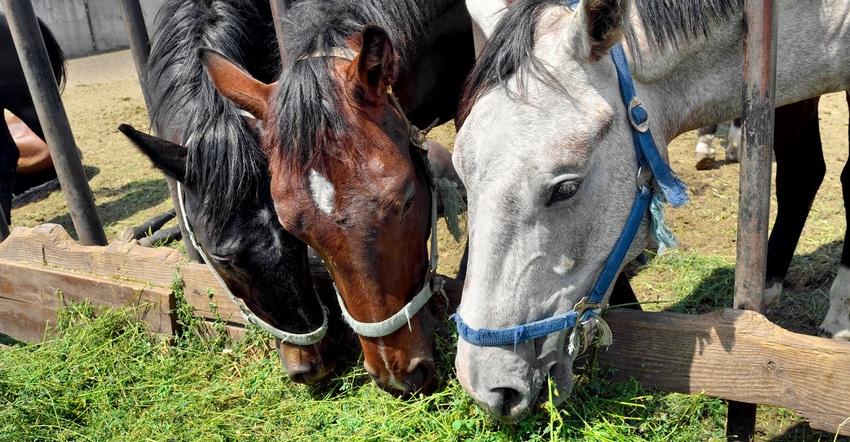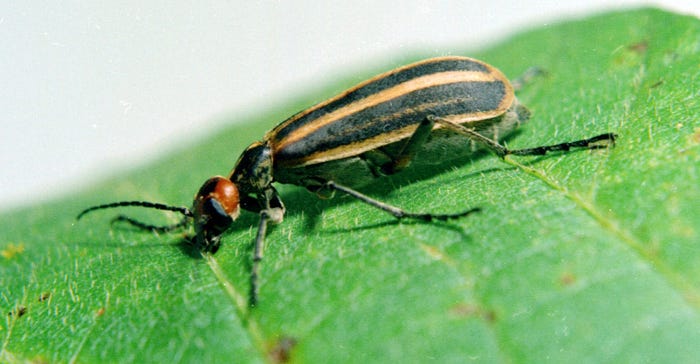
Dead or alive, it is amazing how much damage a 1-inch beetle can do. Ingesting less than five striped blister beetles can cause colic in horses, and eating 30 can result in death.
And these toxic pests don’t need to be alive to inflict harm. Even dried beetle remains in harvested hay are poisonous to livestock.
While there are many different species of blister beetles, University of Missouri Extension agronomy specialist Pat Miller says, farmers raising alfalfa need to develop a management plan to safeguard livestock from one in particular — the striped blister beetle.
“The striped blister beetle has the highest amount of cantharidin and is associated with sickness in livestock,” she explains in a recent MU Forage & Livestock Town Hall.
Cantharidin is a blistering agent that when consumed causes irritation and damage to the digestive system. The animal becomes sick and can ultimately die.
Blister beetles basics
These beetles are easy to recognize by their narrow, slim body, and they appear to have a “neck.” They range in color from black to gray to brown, and some have orange stripes.
“They feed on grasshopper eggs over the winter,” Miller explains, “so if we have a big grasshopper year, we might have more blister beetles that next year.”

SUMMER SLAYER: This small striped blister beetle creates a deadly toxin. When ingested by livestock, whether live or crushed in alfalfa hay, it can cause illness. However, it is often fatal for horses.
Typically, the beetles are not a problem for first-cutting alfalfa. For Missouri, the striped blister beetle, Epicauta vittate, shows up in alfalfa fields in July and August. “They are also the one that swarms,” Miller notes. “I've seen them be nearly a quarter of an acre swarm.”
The problem comes during harvest when farmers run a mower and a hay conditioner in a field. It crushes the striped blister beetle, Miller explains, but cantharidin does not break down. “So, if you've got dead beetles or dead beetle guts crushed into that hay, that poison stays in there, and it stays toxic.”
Management options for farmers
To reduce releasing the number of blister beetles, farmers should consider the following management techniques:
Sell or feed first cutting. Striped blister beetles don’t come out in most years until the second cutting of alfalfa. Miller warns that wet weather may have some farmers completing first cutting at second cutting. Inspect later-harvested fields.
Control weeds. Pigweed is a favorite of blister beetles. Farmers should keep fields weed-free.
Avoid hay conditioners. Miller also says farmers should not use crimping equipment.
Apply insecticide. Scout fields a week before harvest, concentrating on field edges. If blister beetles are present, use carbaryl found in products such as Seven. Farmers will need to wait seven days following application to harvest. Beetles should fall to the ground.
Check hay. Before selling or feeding, check hay for blister beetles. Simply removing the beetles does not make it safe because cantharidin is absorbed by the alfalfa. To be safe, do not feed hay from fields known to have blister beetles to horses.
While these management tips offer ways to reduce blister beetles in a field, Miller warns it will not eliminate their presence. Livestock owners need to continue diligence in inspecting fields and hay for striped blister beetles.
3 myths of harvesting alfalfa without blister beetles
Over the years, University of Missouri Extension agronomy specialist Pat Miller found several methods farmers rely on when harvesting alfalfa infested with blister beetles. She says most do not work. Here are a few of her favorite practices farmers try:
Harvest alfalfa before bloom. Blister beetles prefer to feed on flowers. However, while scouting, Miller found just as many blister beetles in the alfalfa before bloom as when it was blooming.
“They didn't seem to care,” she says. “I've seen them on alfalfa that was 3-to-4 inches tall. So the striped one that makes the swarms is not one that needs to feed on flowers.”
Use a sickle bar mower. Miller says this sounds like a good harvest method instead of using a conditioner that crushes them. However, research in Kansas showed that when farmers lay down a windrow, they drive over that windrow to have that sickle bar mower cut the next cutting. “When you drive over that last windrow, you're going to crush the blister beetles that might be there in that windrow,” she explains. Again, that releases toxins into the hay.
Avoid the swarm. One of Miller’s favorites is, “I’ll see the swarm when I’m mowing, and I’ll be able to avoid it.” She notes that scouting fields for the past six years, she’s stood in a swarm and didn’t even realize it. She adds that seeing it while riding on a tractor is less likely, and going around it will be almost impossible.
About the Author(s)
You May Also Like






